Detailed Employment Law Report: Regulations, Rights, and Etisalat
VerifiedAdded on 2020/09/08
|19
|6269
|357
Report
AI Summary
This report provides a comprehensive overview of employment law, focusing on the relationship between employers and employees, particularly within the context of Etisalat. It examines the purposes and objectives of employment regulations, the roles of tribunals and courts in imposing employment law, and the settlement of cases. The report delves into discrimination law in recruitment and selection, the formation and essential elements of employment contracts, and lawful contract modifications. It also covers redundancy law, business transfers, statutory rights of workers, equal pay, maternity/paternity rights, health and safety requirements, implied duties, and freedom of association. Furthermore, it discusses unfair dismissal, focusing on capability and misconduct, and the rights of employees during disciplinary and grievance hearings. The report highlights key legal requirements, principles, and practical considerations relevant to employment law, offering insights into how these principles apply within an organizational setting like Etisalat.
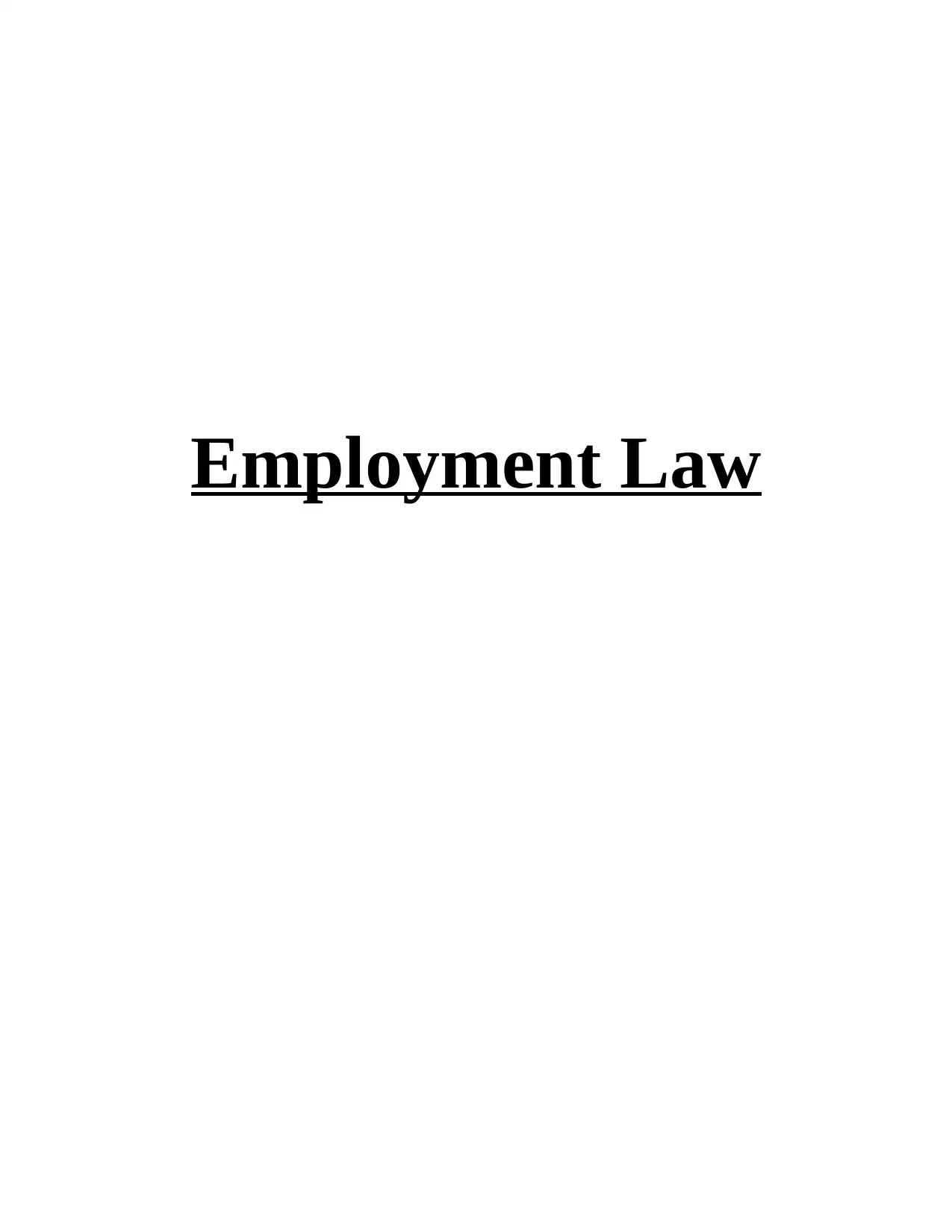
Employment Law
Paraphrase This Document
Need a fresh take? Get an instant paraphrase of this document with our AI Paraphraser
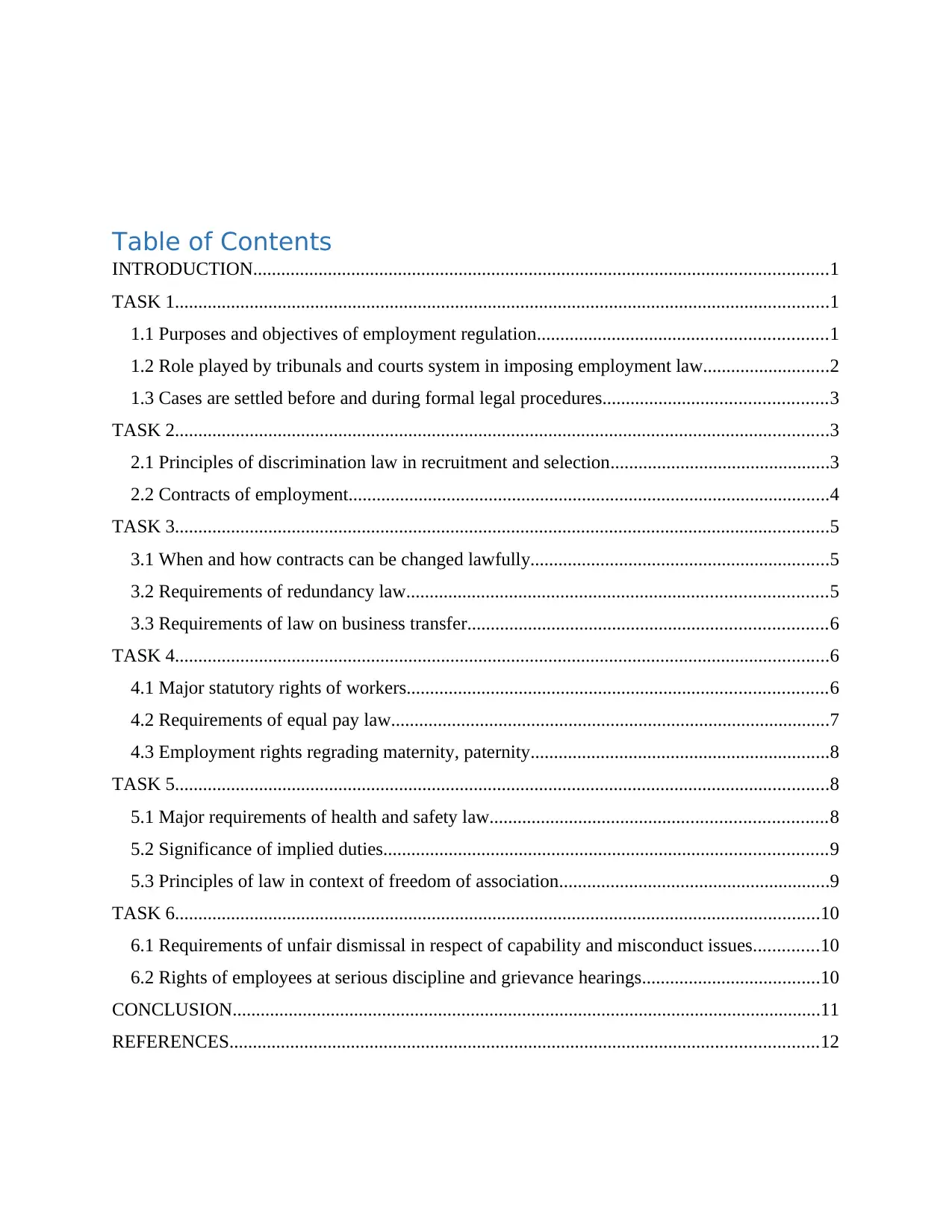
Table of Contents
INTRODUCTION...........................................................................................................................1
TASK 1............................................................................................................................................1
1.1 Purposes and objectives of employment regulation..............................................................1
1.2 Role played by tribunals and courts system in imposing employment law...........................2
1.3 Cases are settled before and during formal legal procedures................................................3
TASK 2............................................................................................................................................3
2.1 Principles of discrimination law in recruitment and selection...............................................3
2.2 Contracts of employment.......................................................................................................4
TASK 3............................................................................................................................................5
3.1 When and how contracts can be changed lawfully................................................................5
3.2 Requirements of redundancy law..........................................................................................5
3.3 Requirements of law on business transfer.............................................................................6
TASK 4............................................................................................................................................6
4.1 Major statutory rights of workers..........................................................................................6
4.2 Requirements of equal pay law..............................................................................................7
4.3 Employment rights regrading maternity, paternity................................................................8
TASK 5............................................................................................................................................8
5.1 Major requirements of health and safety law........................................................................8
5.2 Significance of implied duties...............................................................................................9
5.3 Principles of law in context of freedom of association..........................................................9
TASK 6..........................................................................................................................................10
6.1 Requirements of unfair dismissal in respect of capability and misconduct issues..............10
6.2 Rights of employees at serious discipline and grievance hearings......................................10
CONCLUSION..............................................................................................................................11
REFERENCES..............................................................................................................................12
INTRODUCTION...........................................................................................................................1
TASK 1............................................................................................................................................1
1.1 Purposes and objectives of employment regulation..............................................................1
1.2 Role played by tribunals and courts system in imposing employment law...........................2
1.3 Cases are settled before and during formal legal procedures................................................3
TASK 2............................................................................................................................................3
2.1 Principles of discrimination law in recruitment and selection...............................................3
2.2 Contracts of employment.......................................................................................................4
TASK 3............................................................................................................................................5
3.1 When and how contracts can be changed lawfully................................................................5
3.2 Requirements of redundancy law..........................................................................................5
3.3 Requirements of law on business transfer.............................................................................6
TASK 4............................................................................................................................................6
4.1 Major statutory rights of workers..........................................................................................6
4.2 Requirements of equal pay law..............................................................................................7
4.3 Employment rights regrading maternity, paternity................................................................8
TASK 5............................................................................................................................................8
5.1 Major requirements of health and safety law........................................................................8
5.2 Significance of implied duties...............................................................................................9
5.3 Principles of law in context of freedom of association..........................................................9
TASK 6..........................................................................................................................................10
6.1 Requirements of unfair dismissal in respect of capability and misconduct issues..............10
6.2 Rights of employees at serious discipline and grievance hearings......................................10
CONCLUSION..............................................................................................................................11
REFERENCES..............................................................................................................................12
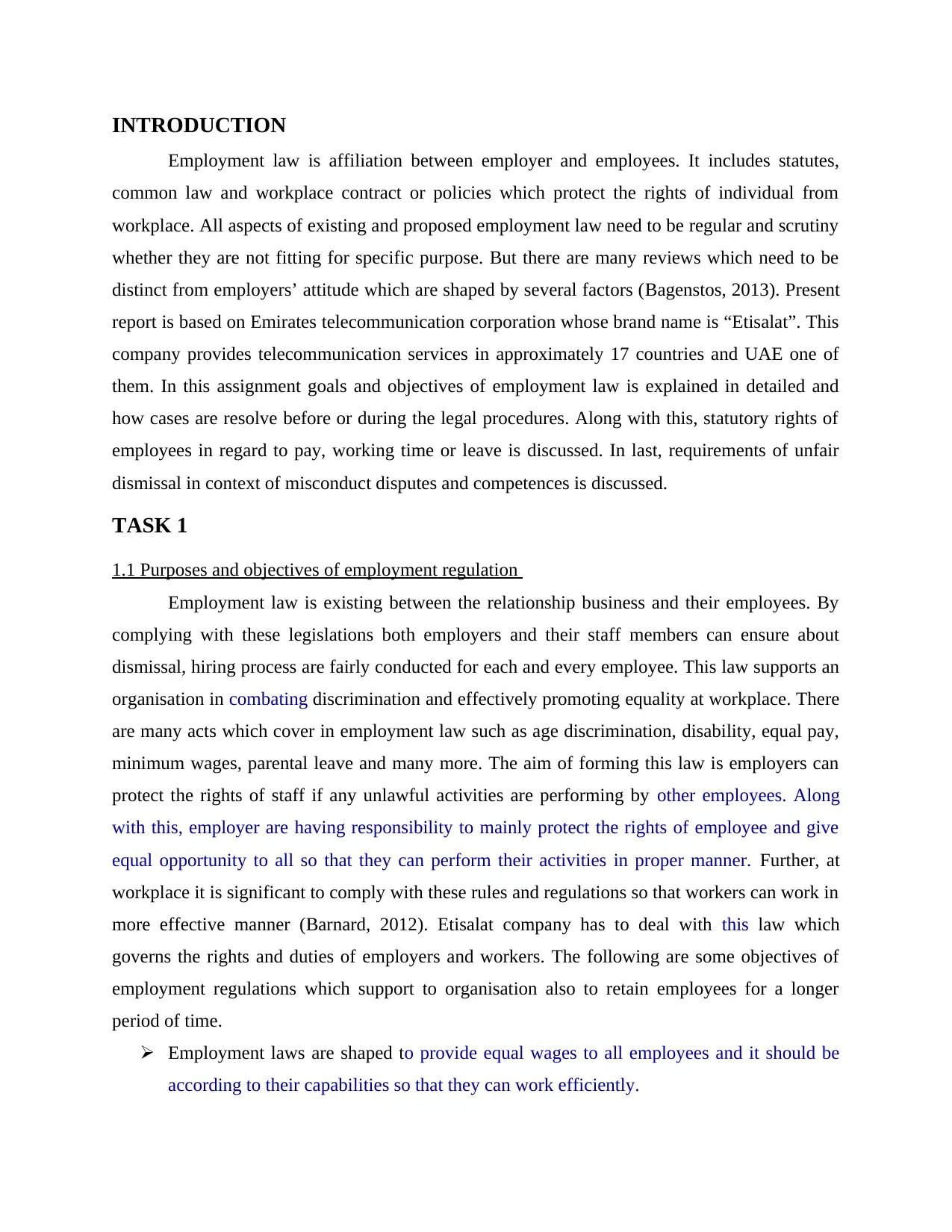
INTRODUCTION
Employment law is affiliation between employer and employees. It includes statutes,
common law and workplace contract or policies which protect the rights of individual from
workplace. All aspects of existing and proposed employment law need to be regular and scrutiny
whether they are not fitting for specific purpose. But there are many reviews which need to be
distinct from employers’ attitude which are shaped by several factors (Bagenstos, 2013). Present
report is based on Emirates telecommunication corporation whose brand name is “Etisalat”. This
company provides telecommunication services in approximately 17 countries and UAE one of
them. In this assignment goals and objectives of employment law is explained in detailed and
how cases are resolve before or during the legal procedures. Along with this, statutory rights of
employees in regard to pay, working time or leave is discussed. In last, requirements of unfair
dismissal in context of misconduct disputes and competences is discussed.
TASK 1
1.1 Purposes and objectives of employment regulation
Employment law is existing between the relationship business and their employees. By
complying with these legislations both employers and their staff members can ensure about
dismissal, hiring process are fairly conducted for each and every employee. This law supports an
organisation in combating discrimination and effectively promoting equality at workplace. There
are many acts which cover in employment law such as age discrimination, disability, equal pay,
minimum wages, parental leave and many more. The aim of forming this law is employers can
protect the rights of staff if any unlawful activities are performing by other employees. Along
with this, employer are having responsibility to mainly protect the rights of employee and give
equal opportunity to all so that they can perform their activities in proper manner. Further, at
workplace it is significant to comply with these rules and regulations so that workers can work in
more effective manner (Barnard, 2012). Etisalat company has to deal with this law which
governs the rights and duties of employers and workers. The following are some objectives of
employment regulations which support to organisation also to retain employees for a longer
period of time.
Employment laws are shaped to provide equal wages to all employees and it should be
according to their capabilities so that they can work efficiently.
Employment law is affiliation between employer and employees. It includes statutes,
common law and workplace contract or policies which protect the rights of individual from
workplace. All aspects of existing and proposed employment law need to be regular and scrutiny
whether they are not fitting for specific purpose. But there are many reviews which need to be
distinct from employers’ attitude which are shaped by several factors (Bagenstos, 2013). Present
report is based on Emirates telecommunication corporation whose brand name is “Etisalat”. This
company provides telecommunication services in approximately 17 countries and UAE one of
them. In this assignment goals and objectives of employment law is explained in detailed and
how cases are resolve before or during the legal procedures. Along with this, statutory rights of
employees in regard to pay, working time or leave is discussed. In last, requirements of unfair
dismissal in context of misconduct disputes and competences is discussed.
TASK 1
1.1 Purposes and objectives of employment regulation
Employment law is existing between the relationship business and their employees. By
complying with these legislations both employers and their staff members can ensure about
dismissal, hiring process are fairly conducted for each and every employee. This law supports an
organisation in combating discrimination and effectively promoting equality at workplace. There
are many acts which cover in employment law such as age discrimination, disability, equal pay,
minimum wages, parental leave and many more. The aim of forming this law is employers can
protect the rights of staff if any unlawful activities are performing by other employees. Along
with this, employer are having responsibility to mainly protect the rights of employee and give
equal opportunity to all so that they can perform their activities in proper manner. Further, at
workplace it is significant to comply with these rules and regulations so that workers can work in
more effective manner (Barnard, 2012). Etisalat company has to deal with this law which
governs the rights and duties of employers and workers. The following are some objectives of
employment regulations which support to organisation also to retain employees for a longer
period of time.
Employment laws are shaped to provide equal wages to all employees and it should be
according to their capabilities so that they can work efficiently.
⊘ This is a preview!⊘
Do you want full access?
Subscribe today to unlock all pages.

Trusted by 1+ million students worldwide
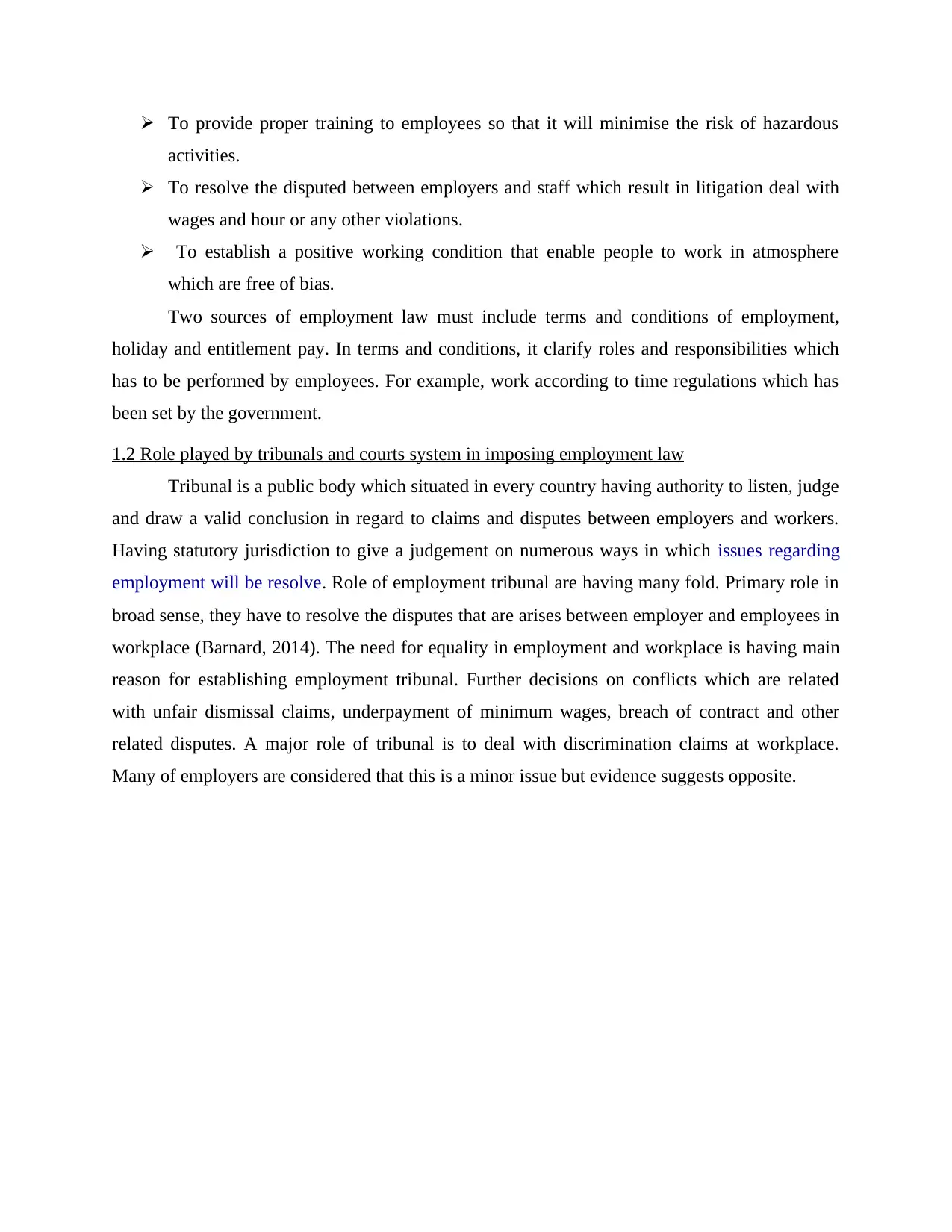
To provide proper training to employees so that it will minimise the risk of hazardous
activities.
To resolve the disputed between employers and staff which result in litigation deal with
wages and hour or any other violations.
To establish a positive working condition that enable people to work in atmosphere
which are free of bias.
Two sources of employment law must include terms and conditions of employment,
holiday and entitlement pay. In terms and conditions, it clarify roles and responsibilities which
has to be performed by employees. For example, work according to time regulations which has
been set by the government.
1.2 Role played by tribunals and courts system in imposing employment law
Tribunal is a public body which situated in every country having authority to listen, judge
and draw a valid conclusion in regard to claims and disputes between employers and workers.
Having statutory jurisdiction to give a judgement on numerous ways in which issues regarding
employment will be resolve. Role of employment tribunal are having many fold. Primary role in
broad sense, they have to resolve the disputes that are arises between employer and employees in
workplace (Barnard, 2014). The need for equality in employment and workplace is having main
reason for establishing employment tribunal. Further decisions on conflicts which are related
with unfair dismissal claims, underpayment of minimum wages, breach of contract and other
related disputes. A major role of tribunal is to deal with discrimination claims at workplace.
Many of employers are considered that this is a minor issue but evidence suggests opposite.
activities.
To resolve the disputed between employers and staff which result in litigation deal with
wages and hour or any other violations.
To establish a positive working condition that enable people to work in atmosphere
which are free of bias.
Two sources of employment law must include terms and conditions of employment,
holiday and entitlement pay. In terms and conditions, it clarify roles and responsibilities which
has to be performed by employees. For example, work according to time regulations which has
been set by the government.
1.2 Role played by tribunals and courts system in imposing employment law
Tribunal is a public body which situated in every country having authority to listen, judge
and draw a valid conclusion in regard to claims and disputes between employers and workers.
Having statutory jurisdiction to give a judgement on numerous ways in which issues regarding
employment will be resolve. Role of employment tribunal are having many fold. Primary role in
broad sense, they have to resolve the disputes that are arises between employer and employees in
workplace (Barnard, 2014). The need for equality in employment and workplace is having main
reason for establishing employment tribunal. Further decisions on conflicts which are related
with unfair dismissal claims, underpayment of minimum wages, breach of contract and other
related disputes. A major role of tribunal is to deal with discrimination claims at workplace.
Many of employers are considered that this is a minor issue but evidence suggests opposite.
Paraphrase This Document
Need a fresh take? Get an instant paraphrase of this document with our AI Paraphraser
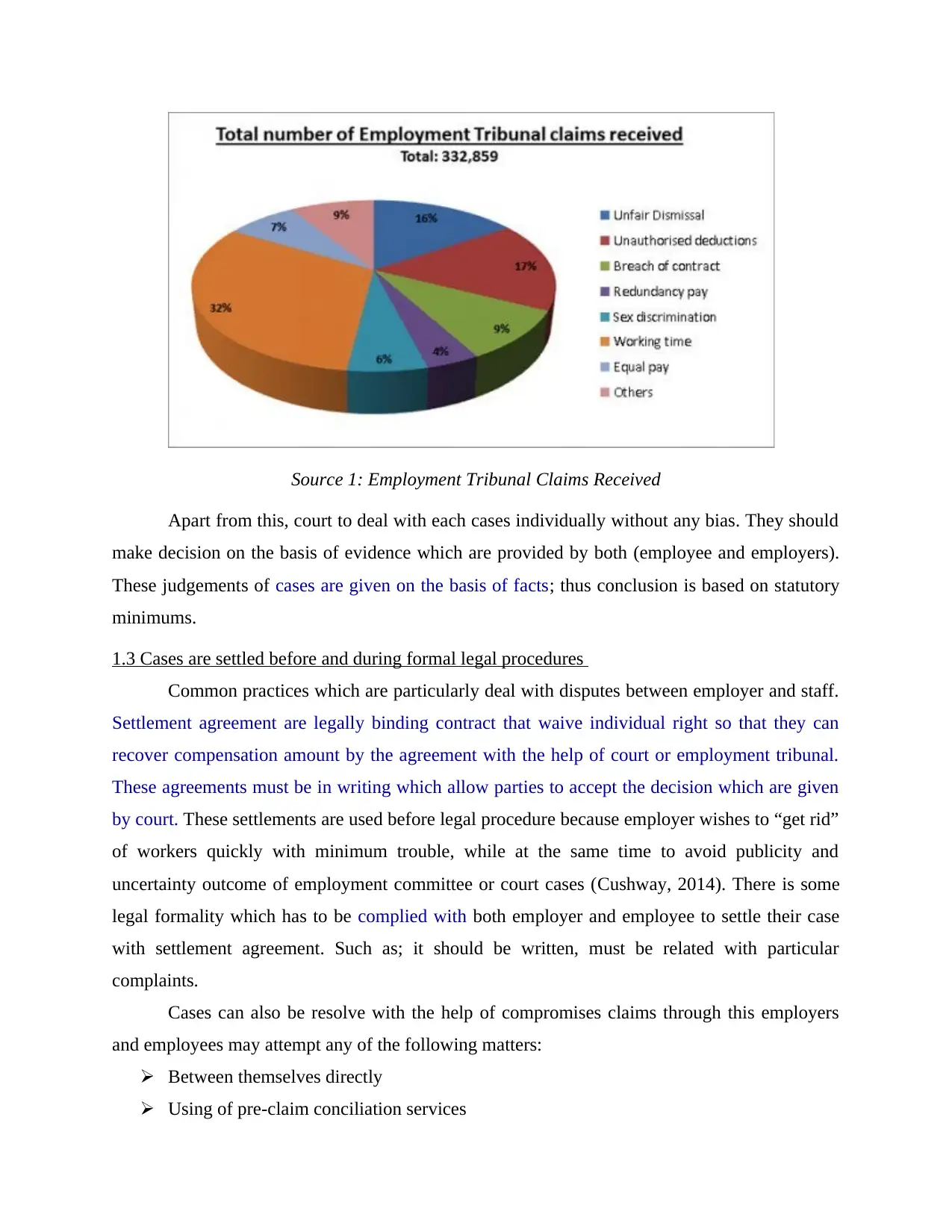
Source 1: Employment Tribunal Claims Received
Apart from this, court to deal with each cases individually without any bias. They should
make decision on the basis of evidence which are provided by both (employee and employers).
These judgements of cases are given on the basis of facts; thus conclusion is based on statutory
minimums.
1.3 Cases are settled before and during formal legal procedures
Common practices which are particularly deal with disputes between employer and staff.
Settlement agreement are legally binding contract that waive individual right so that they can
recover compensation amount by the agreement with the help of court or employment tribunal.
These agreements must be in writing which allow parties to accept the decision which are given
by court. These settlements are used before legal procedure because employer wishes to “get rid”
of workers quickly with minimum trouble, while at the same time to avoid publicity and
uncertainty outcome of employment committee or court cases (Cushway, 2014). There is some
legal formality which has to be complied with both employer and employee to settle their case
with settlement agreement. Such as; it should be written, must be related with particular
complaints.
Cases can also be resolve with the help of compromises claims through this employers
and employees may attempt any of the following matters:
Between themselves directly
Using of pre-claim conciliation services
Apart from this, court to deal with each cases individually without any bias. They should
make decision on the basis of evidence which are provided by both (employee and employers).
These judgements of cases are given on the basis of facts; thus conclusion is based on statutory
minimums.
1.3 Cases are settled before and during formal legal procedures
Common practices which are particularly deal with disputes between employer and staff.
Settlement agreement are legally binding contract that waive individual right so that they can
recover compensation amount by the agreement with the help of court or employment tribunal.
These agreements must be in writing which allow parties to accept the decision which are given
by court. These settlements are used before legal procedure because employer wishes to “get rid”
of workers quickly with minimum trouble, while at the same time to avoid publicity and
uncertainty outcome of employment committee or court cases (Cushway, 2014). There is some
legal formality which has to be complied with both employer and employee to settle their case
with settlement agreement. Such as; it should be written, must be related with particular
complaints.
Cases can also be resolve with the help of compromises claims through this employers
and employees may attempt any of the following matters:
Between themselves directly
Using of pre-claim conciliation services
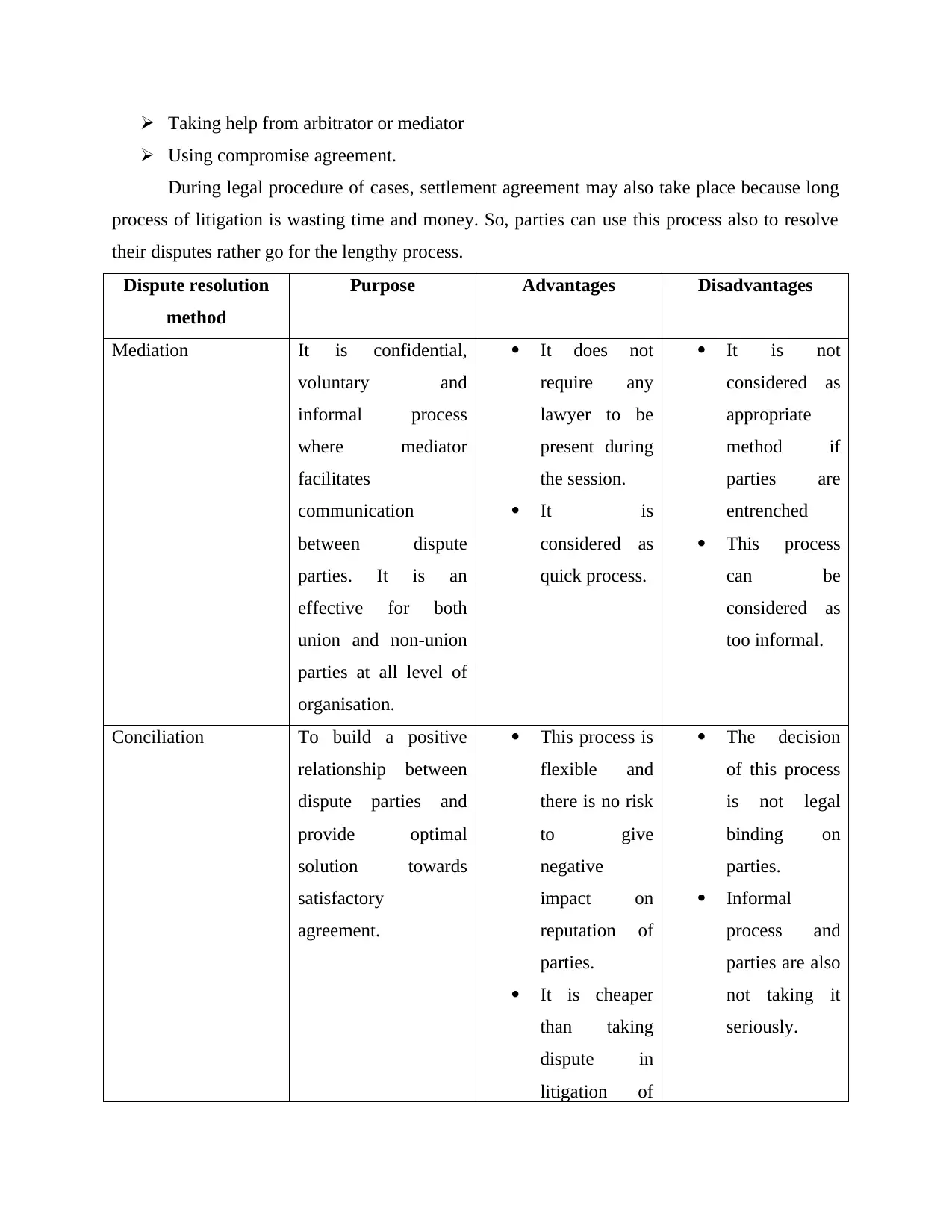
Taking help from arbitrator or mediator
Using compromise agreement.
During legal procedure of cases, settlement agreement may also take place because long
process of litigation is wasting time and money. So, parties can use this process also to resolve
their disputes rather go for the lengthy process.
Dispute resolution
method
Purpose Advantages Disadvantages
Mediation It is confidential,
voluntary and
informal process
where mediator
facilitates
communication
between dispute
parties. It is an
effective for both
union and non-union
parties at all level of
organisation.
It does not
require any
lawyer to be
present during
the session.
It is
considered as
quick process.
It is not
considered as
appropriate
method if
parties are
entrenched
This process
can be
considered as
too informal.
Conciliation To build a positive
relationship between
dispute parties and
provide optimal
solution towards
satisfactory
agreement.
This process is
flexible and
there is no risk
to give
negative
impact on
reputation of
parties.
It is cheaper
than taking
dispute in
litigation of
The decision
of this process
is not legal
binding on
parties.
Informal
process and
parties are also
not taking it
seriously.
Using compromise agreement.
During legal procedure of cases, settlement agreement may also take place because long
process of litigation is wasting time and money. So, parties can use this process also to resolve
their disputes rather go for the lengthy process.
Dispute resolution
method
Purpose Advantages Disadvantages
Mediation It is confidential,
voluntary and
informal process
where mediator
facilitates
communication
between dispute
parties. It is an
effective for both
union and non-union
parties at all level of
organisation.
It does not
require any
lawyer to be
present during
the session.
It is
considered as
quick process.
It is not
considered as
appropriate
method if
parties are
entrenched
This process
can be
considered as
too informal.
Conciliation To build a positive
relationship between
dispute parties and
provide optimal
solution towards
satisfactory
agreement.
This process is
flexible and
there is no risk
to give
negative
impact on
reputation of
parties.
It is cheaper
than taking
dispute in
litigation of
The decision
of this process
is not legal
binding on
parties.
Informal
process and
parties are also
not taking it
seriously.
⊘ This is a preview!⊘
Do you want full access?
Subscribe today to unlock all pages.

Trusted by 1+ million students worldwide
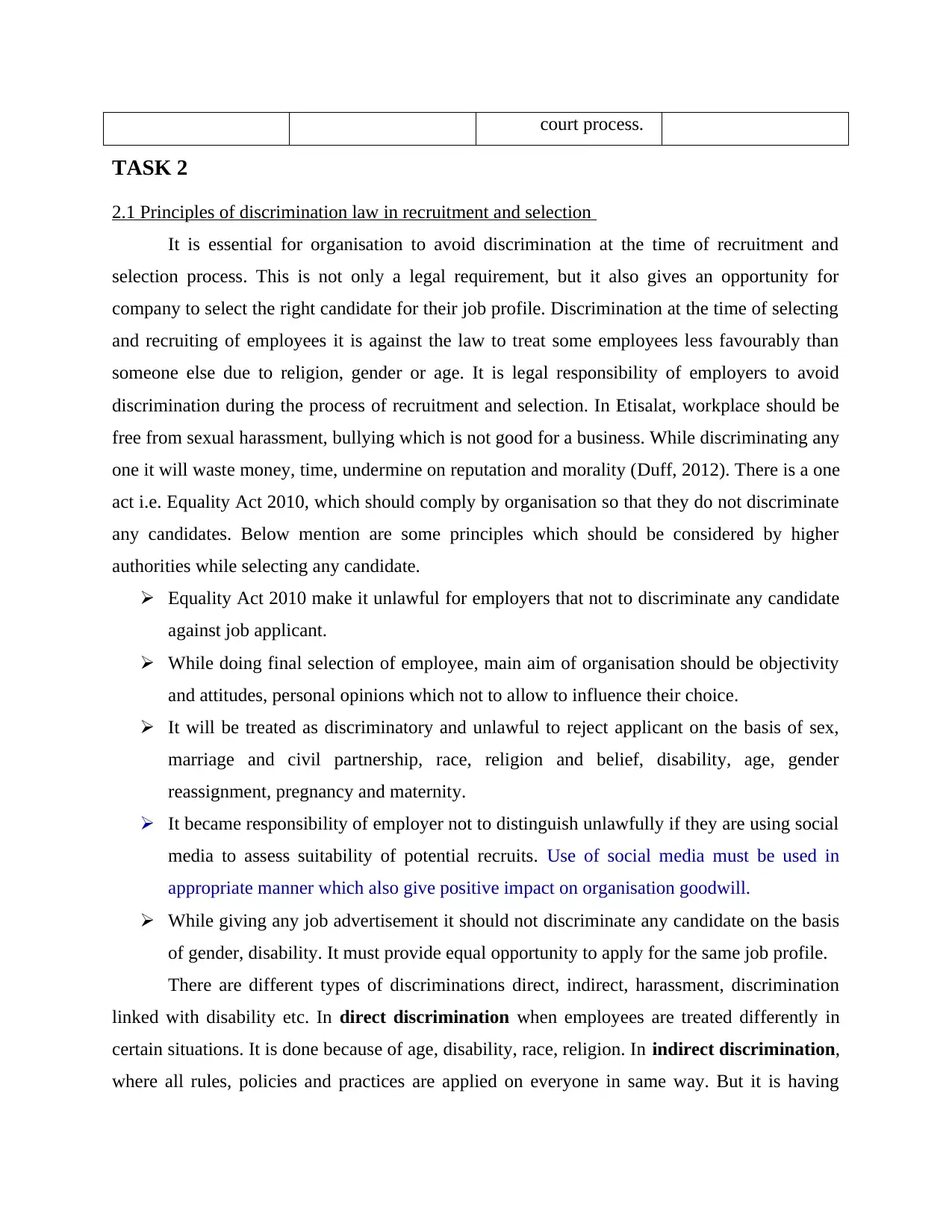
court process.
TASK 2
2.1 Principles of discrimination law in recruitment and selection
It is essential for organisation to avoid discrimination at the time of recruitment and
selection process. This is not only a legal requirement, but it also gives an opportunity for
company to select the right candidate for their job profile. Discrimination at the time of selecting
and recruiting of employees it is against the law to treat some employees less favourably than
someone else due to religion, gender or age. It is legal responsibility of employers to avoid
discrimination during the process of recruitment and selection. In Etisalat, workplace should be
free from sexual harassment, bullying which is not good for a business. While discriminating any
one it will waste money, time, undermine on reputation and morality (Duff, 2012). There is a one
act i.e. Equality Act 2010, which should comply by organisation so that they do not discriminate
any candidates. Below mention are some principles which should be considered by higher
authorities while selecting any candidate.
Equality Act 2010 make it unlawful for employers that not to discriminate any candidate
against job applicant.
While doing final selection of employee, main aim of organisation should be objectivity
and attitudes, personal opinions which not to allow to influence their choice.
It will be treated as discriminatory and unlawful to reject applicant on the basis of sex,
marriage and civil partnership, race, religion and belief, disability, age, gender
reassignment, pregnancy and maternity.
It became responsibility of employer not to distinguish unlawfully if they are using social
media to assess suitability of potential recruits. Use of social media must be used in
appropriate manner which also give positive impact on organisation goodwill.
While giving any job advertisement it should not discriminate any candidate on the basis
of gender, disability. It must provide equal opportunity to apply for the same job profile.
There are different types of discriminations direct, indirect, harassment, discrimination
linked with disability etc. In direct discrimination when employees are treated differently in
certain situations. It is done because of age, disability, race, religion. In indirect discrimination,
where all rules, policies and practices are applied on everyone in same way. But it is having
TASK 2
2.1 Principles of discrimination law in recruitment and selection
It is essential for organisation to avoid discrimination at the time of recruitment and
selection process. This is not only a legal requirement, but it also gives an opportunity for
company to select the right candidate for their job profile. Discrimination at the time of selecting
and recruiting of employees it is against the law to treat some employees less favourably than
someone else due to religion, gender or age. It is legal responsibility of employers to avoid
discrimination during the process of recruitment and selection. In Etisalat, workplace should be
free from sexual harassment, bullying which is not good for a business. While discriminating any
one it will waste money, time, undermine on reputation and morality (Duff, 2012). There is a one
act i.e. Equality Act 2010, which should comply by organisation so that they do not discriminate
any candidates. Below mention are some principles which should be considered by higher
authorities while selecting any candidate.
Equality Act 2010 make it unlawful for employers that not to discriminate any candidate
against job applicant.
While doing final selection of employee, main aim of organisation should be objectivity
and attitudes, personal opinions which not to allow to influence their choice.
It will be treated as discriminatory and unlawful to reject applicant on the basis of sex,
marriage and civil partnership, race, religion and belief, disability, age, gender
reassignment, pregnancy and maternity.
It became responsibility of employer not to distinguish unlawfully if they are using social
media to assess suitability of potential recruits. Use of social media must be used in
appropriate manner which also give positive impact on organisation goodwill.
While giving any job advertisement it should not discriminate any candidate on the basis
of gender, disability. It must provide equal opportunity to apply for the same job profile.
There are different types of discriminations direct, indirect, harassment, discrimination
linked with disability etc. In direct discrimination when employees are treated differently in
certain situations. It is done because of age, disability, race, religion. In indirect discrimination,
where all rules, policies and practices are applied on everyone in same way. But it is having
Paraphrase This Document
Need a fresh take? Get an instant paraphrase of this document with our AI Paraphraser
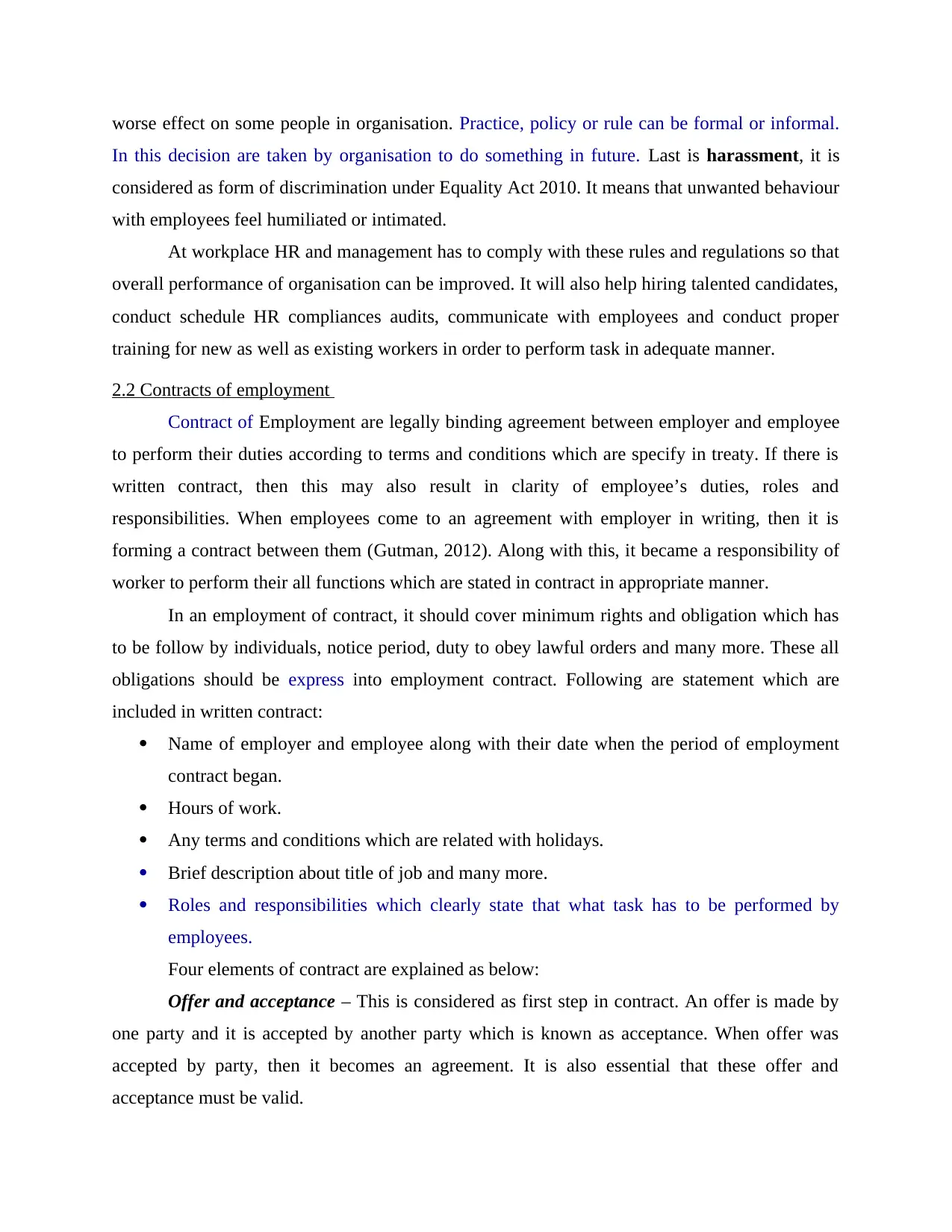
worse effect on some people in organisation. Practice, policy or rule can be formal or informal.
In this decision are taken by organisation to do something in future. Last is harassment, it is
considered as form of discrimination under Equality Act 2010. It means that unwanted behaviour
with employees feel humiliated or intimated.
At workplace HR and management has to comply with these rules and regulations so that
overall performance of organisation can be improved. It will also help hiring talented candidates,
conduct schedule HR compliances audits, communicate with employees and conduct proper
training for new as well as existing workers in order to perform task in adequate manner.
2.2 Contracts of employment
Contract of Employment are legally binding agreement between employer and employee
to perform their duties according to terms and conditions which are specify in treaty. If there is
written contract, then this may also result in clarity of employee’s duties, roles and
responsibilities. When employees come to an agreement with employer in writing, then it is
forming a contract between them (Gutman, 2012). Along with this, it became a responsibility of
worker to perform their all functions which are stated in contract in appropriate manner.
In an employment of contract, it should cover minimum rights and obligation which has
to be follow by individuals, notice period, duty to obey lawful orders and many more. These all
obligations should be express into employment contract. Following are statement which are
included in written contract:
Name of employer and employee along with their date when the period of employment
contract began.
Hours of work.
Any terms and conditions which are related with holidays.
Brief description about title of job and many more.
Roles and responsibilities which clearly state that what task has to be performed by
employees.
Four elements of contract are explained as below:
Offer and acceptance – This is considered as first step in contract. An offer is made by
one party and it is accepted by another party which is known as acceptance. When offer was
accepted by party, then it becomes an agreement. It is also essential that these offer and
acceptance must be valid.
In this decision are taken by organisation to do something in future. Last is harassment, it is
considered as form of discrimination under Equality Act 2010. It means that unwanted behaviour
with employees feel humiliated or intimated.
At workplace HR and management has to comply with these rules and regulations so that
overall performance of organisation can be improved. It will also help hiring talented candidates,
conduct schedule HR compliances audits, communicate with employees and conduct proper
training for new as well as existing workers in order to perform task in adequate manner.
2.2 Contracts of employment
Contract of Employment are legally binding agreement between employer and employee
to perform their duties according to terms and conditions which are specify in treaty. If there is
written contract, then this may also result in clarity of employee’s duties, roles and
responsibilities. When employees come to an agreement with employer in writing, then it is
forming a contract between them (Gutman, 2012). Along with this, it became a responsibility of
worker to perform their all functions which are stated in contract in appropriate manner.
In an employment of contract, it should cover minimum rights and obligation which has
to be follow by individuals, notice period, duty to obey lawful orders and many more. These all
obligations should be express into employment contract. Following are statement which are
included in written contract:
Name of employer and employee along with their date when the period of employment
contract began.
Hours of work.
Any terms and conditions which are related with holidays.
Brief description about title of job and many more.
Roles and responsibilities which clearly state that what task has to be performed by
employees.
Four elements of contract are explained as below:
Offer and acceptance – This is considered as first step in contract. An offer is made by
one party and it is accepted by another party which is known as acceptance. When offer was
accepted by party, then it becomes an agreement. It is also essential that these offer and
acceptance must be valid.
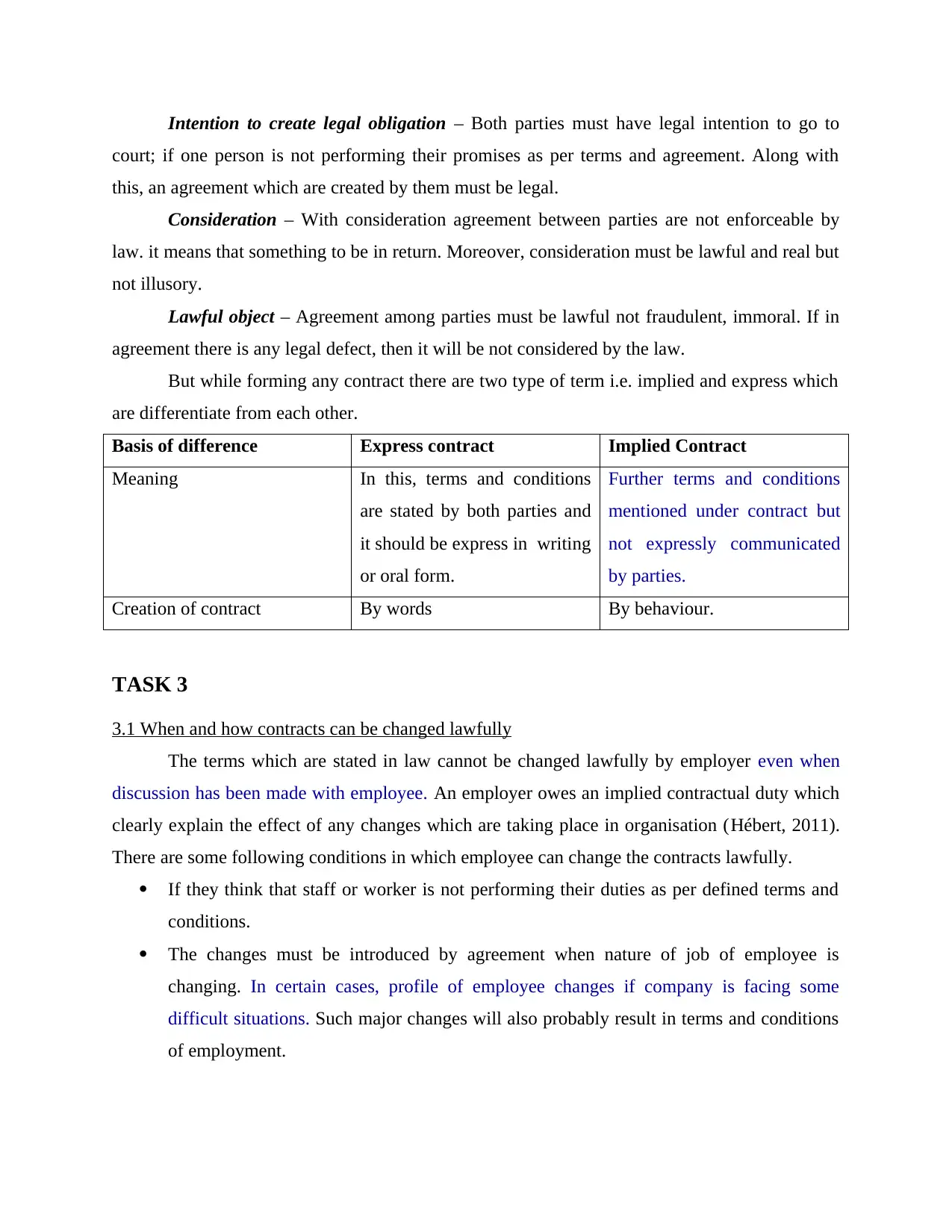
Intention to create legal obligation – Both parties must have legal intention to go to
court; if one person is not performing their promises as per terms and agreement. Along with
this, an agreement which are created by them must be legal.
Consideration – With consideration agreement between parties are not enforceable by
law. it means that something to be in return. Moreover, consideration must be lawful and real but
not illusory.
Lawful object – Agreement among parties must be lawful not fraudulent, immoral. If in
agreement there is any legal defect, then it will be not considered by the law.
But while forming any contract there are two type of term i.e. implied and express which
are differentiate from each other.
Basis of difference Express contract Implied Contract
Meaning In this, terms and conditions
are stated by both parties and
it should be express in writing
or oral form.
Further terms and conditions
mentioned under contract but
not expressly communicated
by parties.
Creation of contract By words By behaviour.
TASK 3
3.1 When and how contracts can be changed lawfully
The terms which are stated in law cannot be changed lawfully by employer even when
discussion has been made with employee. An employer owes an implied contractual duty which
clearly explain the effect of any changes which are taking place in organisation (Hébert, 2011).
There are some following conditions in which employee can change the contracts lawfully.
If they think that staff or worker is not performing their duties as per defined terms and
conditions.
The changes must be introduced by agreement when nature of job of employee is
changing. In certain cases, profile of employee changes if company is facing some
difficult situations. Such major changes will also probably result in terms and conditions
of employment.
court; if one person is not performing their promises as per terms and agreement. Along with
this, an agreement which are created by them must be legal.
Consideration – With consideration agreement between parties are not enforceable by
law. it means that something to be in return. Moreover, consideration must be lawful and real but
not illusory.
Lawful object – Agreement among parties must be lawful not fraudulent, immoral. If in
agreement there is any legal defect, then it will be not considered by the law.
But while forming any contract there are two type of term i.e. implied and express which
are differentiate from each other.
Basis of difference Express contract Implied Contract
Meaning In this, terms and conditions
are stated by both parties and
it should be express in writing
or oral form.
Further terms and conditions
mentioned under contract but
not expressly communicated
by parties.
Creation of contract By words By behaviour.
TASK 3
3.1 When and how contracts can be changed lawfully
The terms which are stated in law cannot be changed lawfully by employer even when
discussion has been made with employee. An employer owes an implied contractual duty which
clearly explain the effect of any changes which are taking place in organisation (Hébert, 2011).
There are some following conditions in which employee can change the contracts lawfully.
If they think that staff or worker is not performing their duties as per defined terms and
conditions.
The changes must be introduced by agreement when nature of job of employee is
changing. In certain cases, profile of employee changes if company is facing some
difficult situations. Such major changes will also probably result in terms and conditions
of employment.
⊘ This is a preview!⊘
Do you want full access?
Subscribe today to unlock all pages.

Trusted by 1+ million students worldwide
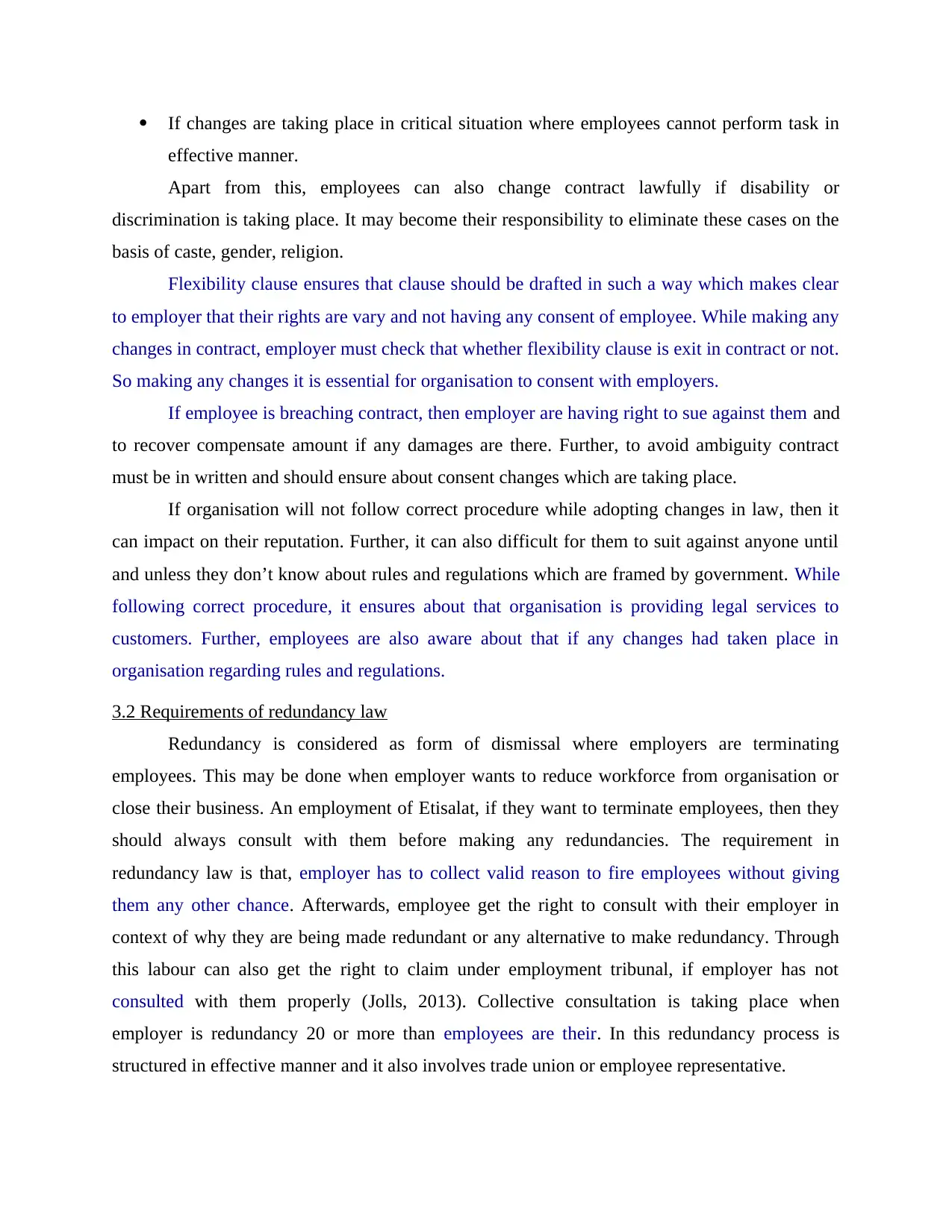
If changes are taking place in critical situation where employees cannot perform task in
effective manner.
Apart from this, employees can also change contract lawfully if disability or
discrimination is taking place. It may become their responsibility to eliminate these cases on the
basis of caste, gender, religion.
Flexibility clause ensures that clause should be drafted in such a way which makes clear
to employer that their rights are vary and not having any consent of employee. While making any
changes in contract, employer must check that whether flexibility clause is exit in contract or not.
So making any changes it is essential for organisation to consent with employers.
If employee is breaching contract, then employer are having right to sue against them and
to recover compensate amount if any damages are there. Further, to avoid ambiguity contract
must be in written and should ensure about consent changes which are taking place.
If organisation will not follow correct procedure while adopting changes in law, then it
can impact on their reputation. Further, it can also difficult for them to suit against anyone until
and unless they don’t know about rules and regulations which are framed by government. While
following correct procedure, it ensures about that organisation is providing legal services to
customers. Further, employees are also aware about that if any changes had taken place in
organisation regarding rules and regulations.
3.2 Requirements of redundancy law
Redundancy is considered as form of dismissal where employers are terminating
employees. This may be done when employer wants to reduce workforce from organisation or
close their business. An employment of Etisalat, if they want to terminate employees, then they
should always consult with them before making any redundancies. The requirement in
redundancy law is that, employer has to collect valid reason to fire employees without giving
them any other chance. Afterwards, employee get the right to consult with their employer in
context of why they are being made redundant or any alternative to make redundancy. Through
this labour can also get the right to claim under employment tribunal, if employer has not
consulted with them properly (Jolls, 2013). Collective consultation is taking place when
employer is redundancy 20 or more than employees are their. In this redundancy process is
structured in effective manner and it also involves trade union or employee representative.
effective manner.
Apart from this, employees can also change contract lawfully if disability or
discrimination is taking place. It may become their responsibility to eliminate these cases on the
basis of caste, gender, religion.
Flexibility clause ensures that clause should be drafted in such a way which makes clear
to employer that their rights are vary and not having any consent of employee. While making any
changes in contract, employer must check that whether flexibility clause is exit in contract or not.
So making any changes it is essential for organisation to consent with employers.
If employee is breaching contract, then employer are having right to sue against them and
to recover compensate amount if any damages are there. Further, to avoid ambiguity contract
must be in written and should ensure about consent changes which are taking place.
If organisation will not follow correct procedure while adopting changes in law, then it
can impact on their reputation. Further, it can also difficult for them to suit against anyone until
and unless they don’t know about rules and regulations which are framed by government. While
following correct procedure, it ensures about that organisation is providing legal services to
customers. Further, employees are also aware about that if any changes had taken place in
organisation regarding rules and regulations.
3.2 Requirements of redundancy law
Redundancy is considered as form of dismissal where employers are terminating
employees. This may be done when employer wants to reduce workforce from organisation or
close their business. An employment of Etisalat, if they want to terminate employees, then they
should always consult with them before making any redundancies. The requirement in
redundancy law is that, employer has to collect valid reason to fire employees without giving
them any other chance. Afterwards, employee get the right to consult with their employer in
context of why they are being made redundant or any alternative to make redundancy. Through
this labour can also get the right to claim under employment tribunal, if employer has not
consulted with them properly (Jolls, 2013). Collective consultation is taking place when
employer is redundancy 20 or more than employees are their. In this redundancy process is
structured in effective manner and it also involves trade union or employee representative.
Paraphrase This Document
Need a fresh take? Get an instant paraphrase of this document with our AI Paraphraser
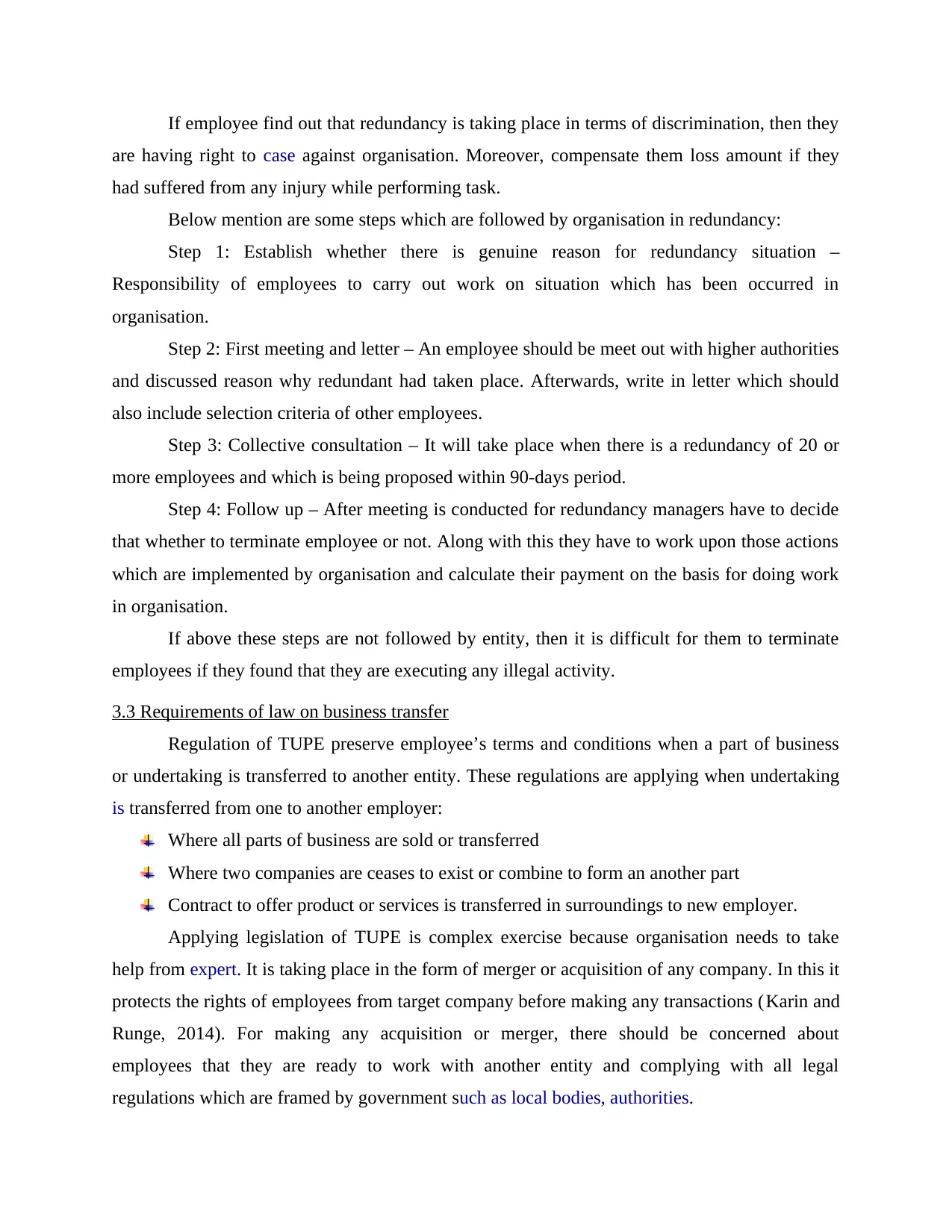
If employee find out that redundancy is taking place in terms of discrimination, then they
are having right to case against organisation. Moreover, compensate them loss amount if they
had suffered from any injury while performing task.
Below mention are some steps which are followed by organisation in redundancy:
Step 1: Establish whether there is genuine reason for redundancy situation –
Responsibility of employees to carry out work on situation which has been occurred in
organisation.
Step 2: First meeting and letter – An employee should be meet out with higher authorities
and discussed reason why redundant had taken place. Afterwards, write in letter which should
also include selection criteria of other employees.
Step 3: Collective consultation – It will take place when there is a redundancy of 20 or
more employees and which is being proposed within 90-days period.
Step 4: Follow up – After meeting is conducted for redundancy managers have to decide
that whether to terminate employee or not. Along with this they have to work upon those actions
which are implemented by organisation and calculate their payment on the basis for doing work
in organisation.
If above these steps are not followed by entity, then it is difficult for them to terminate
employees if they found that they are executing any illegal activity.
3.3 Requirements of law on business transfer
Regulation of TUPE preserve employee’s terms and conditions when a part of business
or undertaking is transferred to another entity. These regulations are applying when undertaking
is transferred from one to another employer:
Where all parts of business are sold or transferred
Where two companies are ceases to exist or combine to form an another part
Contract to offer product or services is transferred in surroundings to new employer.
Applying legislation of TUPE is complex exercise because organisation needs to take
help from expert. It is taking place in the form of merger or acquisition of any company. In this it
protects the rights of employees from target company before making any transactions (Karin and
Runge, 2014). For making any acquisition or merger, there should be concerned about
employees that they are ready to work with another entity and complying with all legal
regulations which are framed by government such as local bodies, authorities.
are having right to case against organisation. Moreover, compensate them loss amount if they
had suffered from any injury while performing task.
Below mention are some steps which are followed by organisation in redundancy:
Step 1: Establish whether there is genuine reason for redundancy situation –
Responsibility of employees to carry out work on situation which has been occurred in
organisation.
Step 2: First meeting and letter – An employee should be meet out with higher authorities
and discussed reason why redundant had taken place. Afterwards, write in letter which should
also include selection criteria of other employees.
Step 3: Collective consultation – It will take place when there is a redundancy of 20 or
more employees and which is being proposed within 90-days period.
Step 4: Follow up – After meeting is conducted for redundancy managers have to decide
that whether to terminate employee or not. Along with this they have to work upon those actions
which are implemented by organisation and calculate their payment on the basis for doing work
in organisation.
If above these steps are not followed by entity, then it is difficult for them to terminate
employees if they found that they are executing any illegal activity.
3.3 Requirements of law on business transfer
Regulation of TUPE preserve employee’s terms and conditions when a part of business
or undertaking is transferred to another entity. These regulations are applying when undertaking
is transferred from one to another employer:
Where all parts of business are sold or transferred
Where two companies are ceases to exist or combine to form an another part
Contract to offer product or services is transferred in surroundings to new employer.
Applying legislation of TUPE is complex exercise because organisation needs to take
help from expert. It is taking place in the form of merger or acquisition of any company. In this it
protects the rights of employees from target company before making any transactions (Karin and
Runge, 2014). For making any acquisition or merger, there should be concerned about
employees that they are ready to work with another entity and complying with all legal
regulations which are framed by government such as local bodies, authorities.
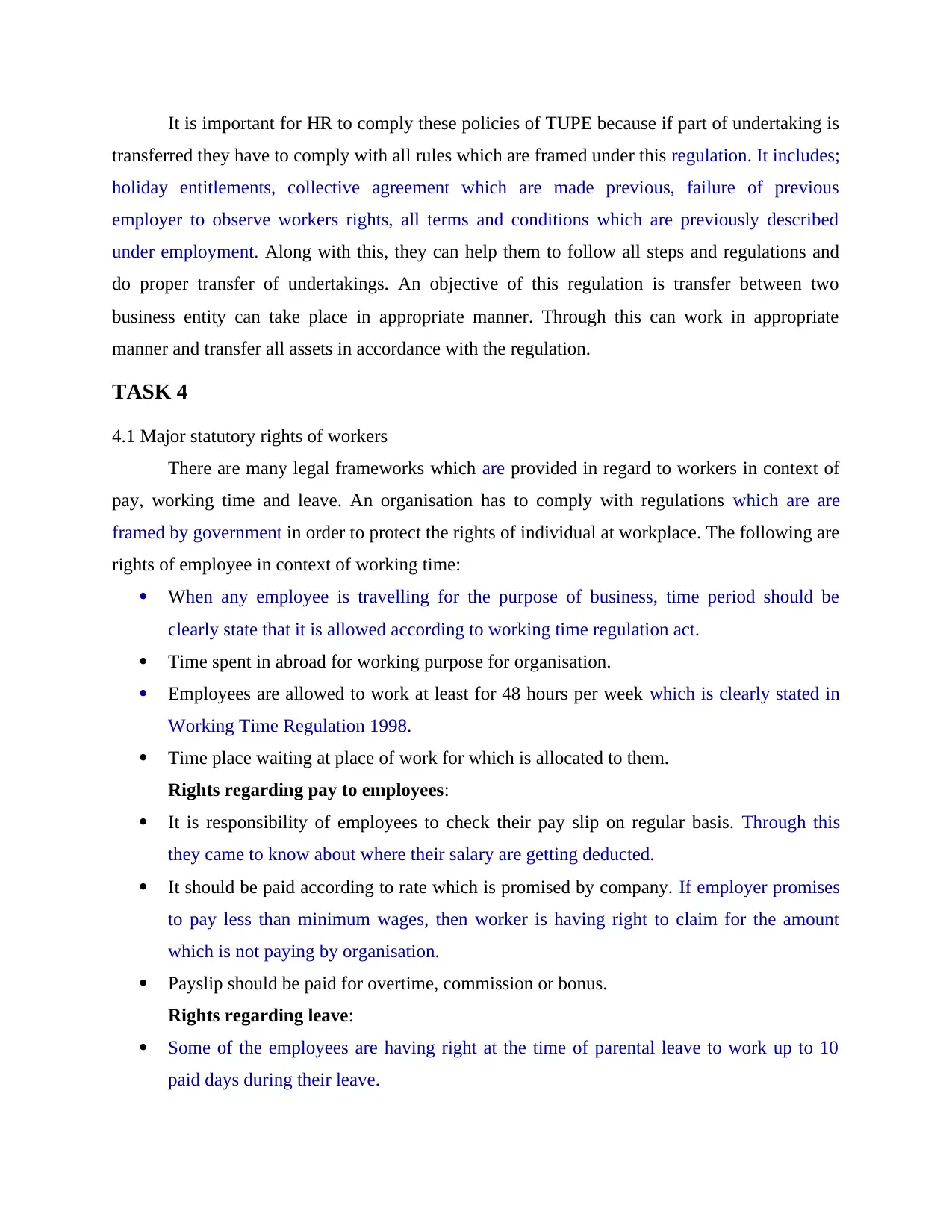
It is important for HR to comply these policies of TUPE because if part of undertaking is
transferred they have to comply with all rules which are framed under this regulation. It includes;
holiday entitlements, collective agreement which are made previous, failure of previous
employer to observe workers rights, all terms and conditions which are previously described
under employment. Along with this, they can help them to follow all steps and regulations and
do proper transfer of undertakings. An objective of this regulation is transfer between two
business entity can take place in appropriate manner. Through this can work in appropriate
manner and transfer all assets in accordance with the regulation.
TASK 4
4.1 Major statutory rights of workers
There are many legal frameworks which are provided in regard to workers in context of
pay, working time and leave. An organisation has to comply with regulations which are are
framed by government in order to protect the rights of individual at workplace. The following are
rights of employee in context of working time:
When any employee is travelling for the purpose of business, time period should be
clearly state that it is allowed according to working time regulation act.
Time spent in abroad for working purpose for organisation.
Employees are allowed to work at least for 48 hours per week which is clearly stated in
Working Time Regulation 1998.
Time place waiting at place of work for which is allocated to them.
Rights regarding pay to employees:
It is responsibility of employees to check their pay slip on regular basis. Through this
they came to know about where their salary are getting deducted.
It should be paid according to rate which is promised by company. If employer promises
to pay less than minimum wages, then worker is having right to claim for the amount
which is not paying by organisation.
Payslip should be paid for overtime, commission or bonus.
Rights regarding leave:
Some of the employees are having right at the time of parental leave to work up to 10
paid days during their leave.
transferred they have to comply with all rules which are framed under this regulation. It includes;
holiday entitlements, collective agreement which are made previous, failure of previous
employer to observe workers rights, all terms and conditions which are previously described
under employment. Along with this, they can help them to follow all steps and regulations and
do proper transfer of undertakings. An objective of this regulation is transfer between two
business entity can take place in appropriate manner. Through this can work in appropriate
manner and transfer all assets in accordance with the regulation.
TASK 4
4.1 Major statutory rights of workers
There are many legal frameworks which are provided in regard to workers in context of
pay, working time and leave. An organisation has to comply with regulations which are are
framed by government in order to protect the rights of individual at workplace. The following are
rights of employee in context of working time:
When any employee is travelling for the purpose of business, time period should be
clearly state that it is allowed according to working time regulation act.
Time spent in abroad for working purpose for organisation.
Employees are allowed to work at least for 48 hours per week which is clearly stated in
Working Time Regulation 1998.
Time place waiting at place of work for which is allocated to them.
Rights regarding pay to employees:
It is responsibility of employees to check their pay slip on regular basis. Through this
they came to know about where their salary are getting deducted.
It should be paid according to rate which is promised by company. If employer promises
to pay less than minimum wages, then worker is having right to claim for the amount
which is not paying by organisation.
Payslip should be paid for overtime, commission or bonus.
Rights regarding leave:
Some of the employees are having right at the time of parental leave to work up to 10
paid days during their leave.
⊘ This is a preview!⊘
Do you want full access?
Subscribe today to unlock all pages.

Trusted by 1+ million students worldwide
1 out of 19
Related Documents
Your All-in-One AI-Powered Toolkit for Academic Success.
+13062052269
info@desklib.com
Available 24*7 on WhatsApp / Email
![[object Object]](/_next/static/media/star-bottom.7253800d.svg)
Unlock your academic potential
Copyright © 2020–2025 A2Z Services. All Rights Reserved. Developed and managed by ZUCOL.





